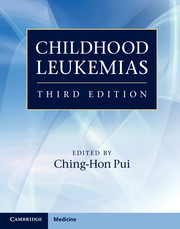Book contents
- Frontmatter
- Contents
- List of contributors
- Preface
- Section 1 History and general issues
- Section 2 Cell biology and pathobiology
- Section 3 Evaluation and treatment
- Section 4 Complications and supportive care
- 29 Acute complications
- 30 Late complications after leukemia therapy
- 31 Therapy-related leukemias
- 32 Infectious complications in leukemia
- 33 Hematologic supportive care
- 34 Pain management
- 35 Psychosocial issues
- 36 Nursing care
- Index
- Plate Section
- References
29 - Acute complications
from Section 4 - Complications and supportive care
Published online by Cambridge University Press: 05 April 2013
- Frontmatter
- Contents
- List of contributors
- Preface
- Section 1 History and general issues
- Section 2 Cell biology and pathobiology
- Section 3 Evaluation and treatment
- Section 4 Complications and supportive care
- 29 Acute complications
- 30 Late complications after leukemia therapy
- 31 Therapy-related leukemias
- 32 Infectious complications in leukemia
- 33 Hematologic supportive care
- 34 Pain management
- 35 Psychosocial issues
- 36 Nursing care
- Index
- Plate Section
- References
Summary
Introduction
The most common cause of early treatment failure among patients with childhood leukemia is death from the acute complications of the leukemia itself or its initial treatment. Despite the increasing intensity of treatment for acute lymphoblastic leukemia (ALL) in children, improvements in supportive care have reduced the rate of death from acute complications from 10% in the early 1970s to under 1% in recent years, and these improvements have had an important impact on event-free survival. In fact, studies of the UK Medical Research Council found that the rate of treatment-related death among children with ALL decreased from 9% in the 1980s (Medical Research Council Working Party on Childhood Leukaemia UKALL VIII trial) to 2% in the 1990s (UKALL X and XI trials). Hence, the 6% improvement in the 5-year event-free survival estimate during the same period (from 55 to 61%) can be attributed largely to advances in supportive care. The rate of toxic death associated with therapy for acute myeloid leukemia (AML) has also decreased over time, but remains unacceptably high at 5–13%. In countries with limited resources, death from toxicity accounts for more cases of treatment failure than does relapse in both AML and ALL.
Acute complications include “early” complications (those occurring within the 2 weeks of starting therapy) and “on-therapy” complications (those occurring after the first 2 weeks of therapy). “Late” complications are those occurring after recovery from the final dose of chemotherapy (Table 29.1). Early complications generally are caused by the leukemia itself, while on-therapy and late complications reflect the toxicity of leukemia therapy. This chapter discusses early and on-therapy complications. The most common early complications include metabolic disturbances, central airway compression, coagulopathy, hyperviscosity/leukostasis, and neurologic dysfunction; whereas, on-therapy complications include hematologic (thrombosis), endocrine (hyperglycemia), gastrointestinal (mucositis, typhlitis, pancreatitis), hepatic (hepatitis), skeletal (osteonecrosis), and neurologic (encephalopathy, myelopathy) disorders.
- Type
- Chapter
- Information
- Childhood Leukemias , pp. 660 - 700Publisher: Cambridge University PressPrint publication year: 2012
References
- 2
- Cited by

